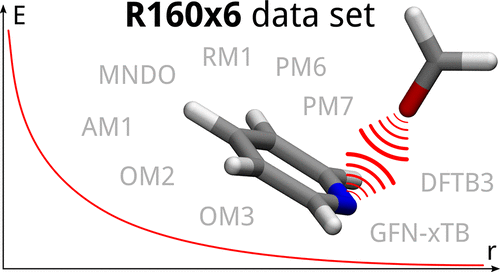当前位置:
X-MOL 学术
›
J. Phys. Chem. A
›
论文详情
Our official English website, www.x-mol.net, welcomes your feedback! (Note: you will need to create a separate account there.)
Testing Semiempirical Quantum Mechanical Methods on a Data Set of Interaction Energies Mapping Repulsive Contacts in Organic Molecules
The Journal of Physical Chemistry A ( IF 2.9 ) Pub Date : 2018-02-23 00:00:00 , DOI: 10.1021/acs.jpca.8b00260 V. M. Miriyala 1 , J. Řezáč 1
The Journal of Physical Chemistry A ( IF 2.9 ) Pub Date : 2018-02-23 00:00:00 , DOI: 10.1021/acs.jpca.8b00260 V. M. Miriyala 1 , J. Řezáč 1
Affiliation

|
Semiempirical quantum mechanical (QM) methods with corrections for noncovalent interactions provide a favorable combination of accuracy and computational efficiency that makes them a useful tool for a study of large molecular systems. It was, however, noted that the accuracy of these methods deteriorates at intermolecular distances shorter than equilibrium. In this work, we explore this issue systematically using a newly developed data set of benchmark interaction energies named R160×6. This data set maps repulsive contacts in organic molecules, and it consists of 160 model complexes for which six points along the dissociation curve are provided. Testing a wide range of semiempirical QM methods against the CCSD(T)/CBS benchmark revealed that most methods, and all the dispersion-corrected ones, underestimate the repulsion systematically. The worst cases are usually hydrogen–hydrogen contacts. The best results were obtained with PM6-D3H4 and DFTB3-D3H4, as these methods already contain a correction for the H–H repulsion, but the errors are still about twice as large as in equilibrium geometries.
中文翻译:

在映射分子中的相互作用能的数据上测试半经验量子力学方法
修正了非共价相互作用的半经验量子力学(QM)方法提供了准确度和计算效率的良好组合,使其成为研究大型分子系统的有用工具。但是,要指出的是,这些方法的精确度在分子间距离短于平衡时会降低。在这项工作中,我们使用名为R160×6的新开发的基准相互作用能的数据集系统地探讨了这个问题。该数据集映射了有机分子中的排斥接触,它由160个模型配合物组成,为它们提供了沿着解离曲线的六个点。根据CCSD(T)/ CBS基准测试了各种半经验QM方法,结果表明,大多数方法以及所有经色散校正的方法都会低估系统排斥力。最坏的情况通常是氢-氢接触。使用PM6-D3H4和DFTB3-D3H4可获得最佳结果,因为这些方法已经对H-H斥力进行了校正,但误差仍约为平衡几何尺寸的两倍。
更新日期:2018-02-23
中文翻译:

在映射分子中的相互作用能的数据上测试半经验量子力学方法
修正了非共价相互作用的半经验量子力学(QM)方法提供了准确度和计算效率的良好组合,使其成为研究大型分子系统的有用工具。但是,要指出的是,这些方法的精确度在分子间距离短于平衡时会降低。在这项工作中,我们使用名为R160×6的新开发的基准相互作用能的数据集系统地探讨了这个问题。该数据集映射了有机分子中的排斥接触,它由160个模型配合物组成,为它们提供了沿着解离曲线的六个点。根据CCSD(T)/ CBS基准测试了各种半经验QM方法,结果表明,大多数方法以及所有经色散校正的方法都会低估系统排斥力。最坏的情况通常是氢-氢接触。使用PM6-D3H4和DFTB3-D3H4可获得最佳结果,因为这些方法已经对H-H斥力进行了校正,但误差仍约为平衡几何尺寸的两倍。



























 京公网安备 11010802027423号
京公网安备 11010802027423号